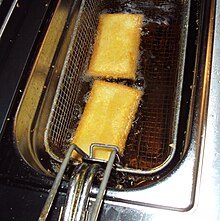Deep frying
This article needs additional citations for verification. (June 2011) |


Deep frying (also referred to as deep fat frying) is a cooking method in which food is submerged in hot fat (e.g., oil). This is normally performed with a deep fryer or chip pan; industrially, a pressure fryer or vacuum fryer may be used.
Deep frying is classified as a dry cooking method because no water is used. Due to the high temperature involved and the high heat conduction of oil, it cooks food extremely quickly.
Technique
If performed properly, deep-frying does not make food excessively greasy, because the moisture in the food repels the oil. The hot oil heats the water within the food, steaming it; oil cannot go against the direction of this powerful flow because (due to its high temperature) the water vapor pushes the bubbles toward the surface.[1] As long as the oil is hot enough and the food is not immersed in the oil for too long, oil penetration will be confined to the outer surface. However, if the food is cooked in the oil for too long, much of the water will be lost and the oil will begin to penetrate the food. The correct frying temperature depends on the thickness and type of food, but in most cases it lies between 175–190 °C (347–374 °F).
Dishes and foods
-
Deep-frying chicken in a pan
-
Breaded, deep-fried calamari
-
Deep fried pork intestines
Oil deterioration
Overheating or over-using the frying oil leads to formation of rancid-tasting products of oxidation, polymerization, and other deleterious, unintended or even toxic compounds[2] such as acrylamide (from starchy foods). Deep-frying under vacuum helps to significantly reduce acrylamide formation,[3] but this process is not widely used in the food industry due to the high investment cost involved.
Some useful tests and indicators of excessive oil deterioration are the following:
- Sensory: Darkening, smoke, foaming, thickening, rancid taste and unpleasant smell when heating. This is the most unreliable way to decide when to change because those are very individual factors and can depend on different causes.
- Tesing Strips: Decide when to change depending on ffa (free fatty acids) only
- Oiltester: Measurement Tool to exactly define the point of change by TPM/TPC (Total Polar Material/Compounds)
- Laboratory: Acidity, anisidine value, viscosity, total polar compounds, polymeric triglycerides.
Instruments that indicate total polar compounds, currently the best single gauge of how deep-fried an object is, are available with sufficient accuracy for restaurant and industry use.
Advantages
- Due to the high temperature, frying is a very fast way to prepare food
- You get unmatched crispy and typically colored (golden brown) products
- Easy way to prepare food
Disadvantages
Deep frying produces large amounts of waste oil, which must be properly disposed of. Waste oil is increasingly being recycled into biodiesel.

Cooking oil is flammable, and fires may be caused by it igniting at too high a temperature. Further, attempts to extinguish an oil fire with water cause an extremely dangerous condition, a boilover, as it causes the water to flash into steam due to the high heat of the oil, in turn sending the burning oil in all directions and thus aggravating the fire. This is the leading cause of house fires in the United Kingdom. Instead, oil fires must be extinguished with a non-water fire extinguisher or by smothering. Other means of extinguishing an oil fire include application of dry powder (e.g., baking soda, salt) or fire fighting foam. Most commercial deep fryers are equipped with automatic fire suppression systems using foam.
The following examples of the disadvantages of cooking oil as follows: Spilled hot cooking oil can also cause severe, even fatal, burns. The higher temperatures and tendency of oil to stick to the skin make spilled hot cooking oil far more dangerous than spilled hot water. Children are particularly one of the risks of cooking oil as they can accidentally place their hands, e.g on top of the stove, playing with the materials while being cooked, allegedly pull the cover from the pot holder, pushing the pot accidentally.
Cooking with oil also tends to make a mess, with oil splatters on all adjacent surfaces, and oil vapors condensing on more distant surfaces. More detergent is also needed to clean cooking pots and utensils coated in oil, either deep frying or normal frying, oil will tend to scatter off the surfaces.
History
The word "deep frying" was not documented until 1930.[4] Historians believe that European and Arabic cultures used deep frying in ancient times and in the Middle Ages.[citation needed] A Roman cookbook, Apicius, appears to list the ancient Romans first use of deep frying to prepare Pullum Frontonianum.[5]
See also
References
- ^ This, Hervé (2006). Molecular Gastronomy. trans. Malcolm DeBevoise. New York: Columbia University Press. p. 63. ISBN 978-0-231-13312-8.
- ^ IARC Working Group on the Evaluation of Carcinogenic Risks to Humans (2010). Household use of solid fuels and high-temperature frying. Lyon, France ; Geneva: Lyon, France : International Agency for Research on Cancer ; Distributed by WHO Press, 2010.
- ^ C. GRANDA, R.G. MOREIRA, S.E. TICHY (2004) Reduction of Acrylamide Formation in Potato Chips by Low-temperature Vacuum Frying Journal of Food Science 69 (8), 405–411.
- ^ "Deep-fry | Define Deep-fry at Dictionary.com". Dictionary.reference.com. Retrieved 2014-05-11.
- ^ "LacusCurtius • Apicius, De Re Coquinaria — Book VI". Penelope.uchicago.edu. Retrieved 2014-05-11.



